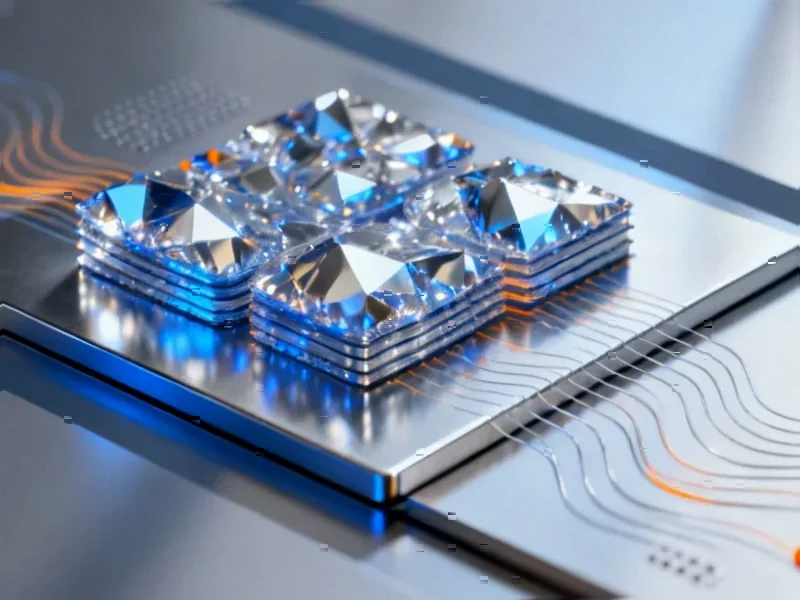According to SciTechDaily, researchers from the USC Viterbi School of Engineering and School of Advanced Computing have developed artificial neurons that physically replicate the complex electrochemical behavior of real brain cells. The breakthrough, detailed in Nature Electronics and led by Professor Joshua Yang, uses “diffusive memristors” that operate using silver ion movement rather than electron flow, requiring only the space of a single transistor compared to the tens to hundreds needed in conventional designs. The technology could dramatically reduce chip size and cut energy consumption by several orders of magnitude while advancing progress toward artificial general intelligence. The research demonstrates how these neurons emulate biological processes using silver ions in oxide to generate electrical pulses similar to how the brain uses potassium, sodium, or calcium ions.
From Simulation to Physical Replication
This represents a fundamental shift in neuromorphic computing philosophy. Previous approaches, including those from Intel’s Loihi and IBM’s TrueNorth, essentially simulated neural behavior using conventional silicon transistors arranged in digital circuits. What makes Yang’s work revolutionary is that the computation happens through the same physical mechanisms as biological neurons—ion diffusion and electrochemical reactions. Rather than treating neural processes as mathematical models to be executed, they’ve created hardware where the physics itself performs the computation. This distinction between simulating and physically embodying neural processes could prove crucial for achieving the brain’s remarkable efficiency in learning and pattern recognition.
The Energy Efficiency Imperative
The timing of this breakthrough couldn’t be more critical for the AI industry. As large language models and machine learning systems consume increasingly unsustainable amounts of energy—some estimates suggest AI could consume as much electricity as entire countries within years—the search for more efficient computing architectures has become urgent. Professor Yang’s observation that “it’s not that our chips or computers are not powerful enough… they aren’t efficient enough” highlights the core challenge facing AI scaling. The human brain’s ability to perform complex learning while consuming only about 20 watts presents both an inspiration and a target that current computing paradigms cannot approach without fundamental architectural changes.
The Road to Commercialization
While the research demonstrates compelling laboratory results, significant manufacturing challenges remain. The use of silver ions presents compatibility issues with conventional semiconductor fabrication processes, which could delay commercial adoption. The semiconductor industry has invested trillions in silicon-based manufacturing infrastructure, and any new technology must either integrate with existing processes or demonstrate overwhelming advantages to justify retooling. Researchers will need to identify alternative ionic species that provide similar functionality while being compatible with CMOS processes, or develop hybrid approaches that leverage both conventional electronics and neuromorphic elements.
Toward More Biological AI
Perhaps the most intriguing aspect of this research is its potential to bridge the gap between artificial and biological intelligence. By building systems that operate on the same physical principles as the brain, we may uncover insights into how biological intelligence emerges from electrochemical processes. This could lead to AI systems that learn more like humans—from few examples rather than thousands, and through physical changes in hardware rather than software parameter adjustments. The implications extend beyond computing efficiency to potentially creating systems that develop more human-like reasoning patterns and cognitive capabilities.
Who Stands to Benefit—and Who Doesn’t
The development poses interesting questions about future industry dynamics. Companies heavily invested in traditional AI hardware, particularly those manufacturing GPUs and specialized AI accelerators, may face disruption if neuromorphic computing gains traction. Meanwhile, organizations working on edge AI, robotics, and applications where power constraints are critical could benefit enormously from orders-of-magnitude efficiency improvements. The technology could enable intelligent systems in environments where power availability is limited, from medical implants to remote sensors, potentially creating entirely new categories of smart devices that operate for years on minimal power.
The Path Forward
The next critical phase involves scaling from individual components to integrated systems. As Yang notes, the challenge now is to integrate large numbers of these artificial neurons and synapses and test whether their collective behavior can replicate the brain’s capabilities. This integration challenge is non-trivial—biological brains derive their power from complex, hierarchical networks of billions of neurons, and simply having efficient components doesn’t guarantee efficient systems. The research community will need to develop new architectures and programming models that leverage these physical properties rather than treating them as drop-in replacements for conventional computing elements.




